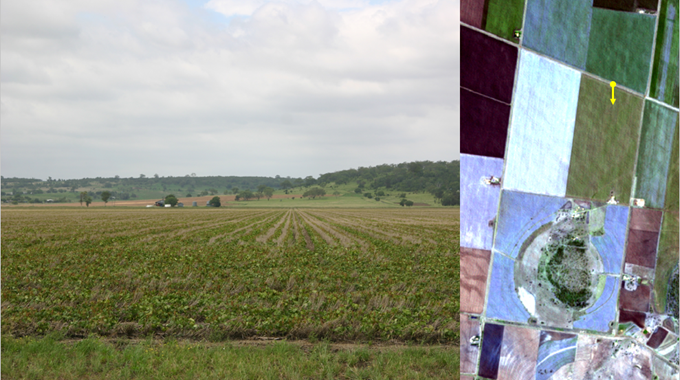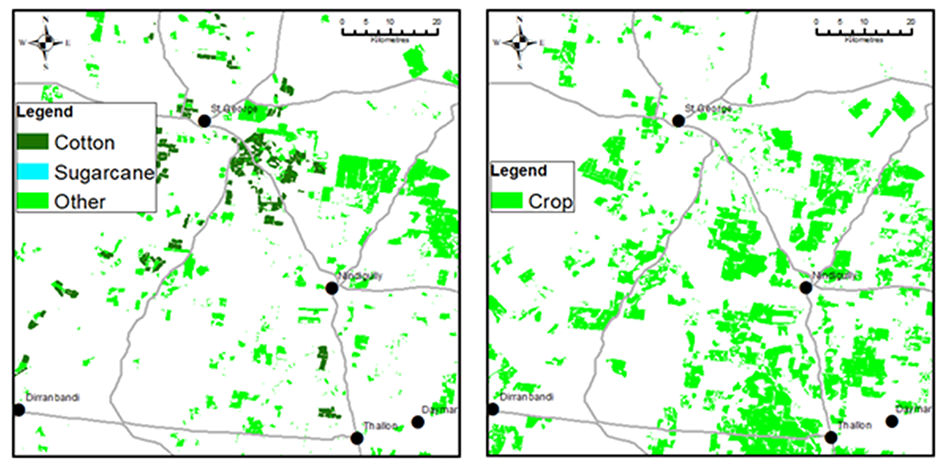Crop mapping


Remote sensing scientists use satellite imagery to detect the growth of broadacre crops in Queensland. They have analysed satellite imagery back to 1988 and produced an archive of two maps per year: one for winter-growing crops (i.e. June to October), and one for summer-growing crops (November to May). In summer the crop maps show these classes:
- ‘Cotton’.
- ‘Sugarcane’.
- ‘Other’ (predominantly sorghum, but also includes maize, peanut, soybean, and mungbean).
In winter, only a generic ‘Crop’ class is mapped (predominantly wheat, but also includes barley and chickpea). For simplicity, our scientists map sugarcane only in summer when it is generally in its peak growing period, even though it grows all year round.


How can crop maps be used?
Satellite-derived crop maps deliver spatially comprehensive information that can be used for a range of strategic planning activities, including:
- protection of strategic cropping lands
- improving our understanding of the water quality of rivers
- prioritising improvements to transportation infrastructure
- informing land valuations
- directing response efforts following a natural disaster
- studying the long-term effects of cropping on ecosystem services.
How are crop maps made?
To make a crop map, scientists process satellite imagery for a period of interest, in a high-performance computing facility. The basic procedure is:
- Download Landsat and MODIS imagery from the United States Geological Survey, and Sentinel-2 imagery from the European Space Agency.
- Pre-process the imagery to correct for sensor, atmospheric and landscape effects, to ensure different dates can be compared, and exclude areas covered by clouds and cloud-shadows.
- Assemble the imagery as a time-series. Calculate the seasonal vegetation parameters across the landscape.
- Apply a rigorously validated statistical model to predict the most-likely crop class across the landscape, according to the growing season and the seasonal vegetation parameters.
- Publish the map online.
The primary source of satellite imagery is the Landsat mission. Landsat satellites have a 30-metre pixel size, and revisit every point on Earth every eight days. Since 2015, Sentinel-2 imagery is also included. Sentinel-2 has a revisit time of five days and helps to fill gaps in the Landsat time-series due to cloud. Sentinel-2 has a pixel size of 10 to 20 metres but, for ease of use in the crop model, it is resized to 30 metres, to match Landsat. MODIS imagery, available since 2000, is acquired daily, but at a relatively large pixel size of 250 metres. MODIS hence serves only as a backup when there is a relatively long absence of Landsat and Sentinel-2 imagery.
Where can I get the data?
Crop maps are available at:
- the Queensland Government’s QSpatial data catalogue (use the search term ‘seasonal crop’); and,
- the Terrestrial Ecosystem Research Network.
Based on the historical archive of crop maps, reports that summarise the frequency of cropping, on a lot-on-plan basis, are available from the FORAGE reporting system.
Contact us
For more information about crop mapping, contact the Science Leader via email dan.tindall@des.qld.gov.au, Remote Sensing Sciences.


